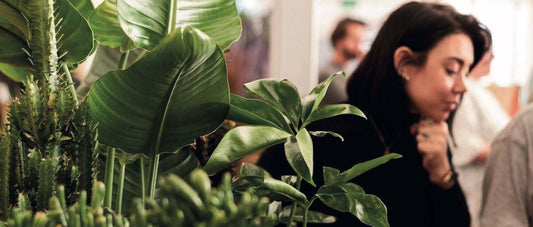Spring is a beautiful season for the longer days, the joyous flowers, and the foods that nature so bountifully provides. After a long chilly winter there’s nothing more delightful than heading out into the wild to hunt for delicious (and *free*) plants, herbs, and fruits. Thanks, Mother Nature!
Equipment
April is the season to hunt for fresh new greens and herbs to give your meals a seasonal flavour bomb. It's also a great time to make sure you’re well-equipped with equipment to keep you and your pals comfy and practical. Below you'll find a short list of sustainable, eco-friendly products we stock at Prior, to give your foraging adventure a little lift.
These beautiful foraging and lunch bags from Bristol-brand BRIC are the perfect thing to collect your findings in. In an array of different colours and styles, sizes and options, they’re the perfect thing to tuck away berries and leaves in.
This picnic rug from The Tartan Blanket Company has a waterproof backing, meaning it’s ideal for whipping out and taking on foraging adventures. Lightweight, washable, and (importantly), beautiful. What more could you look for in a rug?
It’s important to stay hydrated whilst on your nature trips. These reusable water bottles from Kept are durable and the perfect size to take out and about.
This maker’s balm from eco-brand Old Faithful is the perfect thing for calming working hands - or popping on any patch of skin that needs a little love. Ideal for hardworking foraging hands, and made from all natural products, it’s an ideal pick-me-up after a trip into nature.
Staying Safe
And just one last thing - before the foraging commences, it’s important to equip yourself with information to keep both you, and the foraging stocks, safe when collecting your plants. Have a peek at the responsible foraging guidelines as written by the Woodland Trust, to make sure you’re staying in the green, and the green stays safe, too.
Without further ado, here’s 5 easily-identifiable edible plants to keep an eye out for this spring:
Alexanders
Also known as horse parsley, every part of the plant is edible - but the delicious stem, flowers and leaf tips are the best bits. Often compared to angelica or parsley, there are myriad ways to bring out it’s best side: steam, boil, season, butter, or do as the Swiss do, and deep fry the flowers! Flowers and leaves can be eaten raw and added to salads or as a garnish to soups.
Where and what to look for: widespread in coastal regions in the South of England - along cliff tops and hedges. The first flower buds appear in late March and April - so perfect for foraging now!
Bramble leaves
Bramble, normally associated with their autumnal fruit bounty of blackberries, is a bit of a dark horse in that the leaves are edible too! The delicious foliage is packed with antioxidants and vitamin C and have been used and loved for their medicinal properties - they’re astringents, meaning they have a drying and tightening effect.
How to use: to treat mouth ulcers, and sore throats, you can make a delicious fruity wild tea with a few fresh or dried leaves. Infuse in hot water for 5 minutes, and sweeten with honey or agave to encourage its consumption.
Where and what to look for: bramble is considered an aggregate of hundreds of different microspecies, but they are simple to identify. Look for long, rambling, thorny, reddish-green stems. The young, green, tender leaves are perfect for picking in April.
Cow Parsley
Sometimes also known as wild chervil, this rambunctious plant is an excellent all-round herb. As a member of the carrot family, and a biennial, it’s sometimes called mother-die (potentially because of its resemblance to the poisonous hemlock - closely linked with witchcraft.)
In the same family as carrot and parsley, its leaves have a similar flavour. Use as you would parsley, as a garnish or as a salsa verde.
Where and what to look for: often spotted along roadsides, woodland rides and hedgerows, and on waste ground. Its leaves are somewhat fern-like, flowers are tiny and white and umbrella-like in clusters.
Wild Garlic
Everyone’s favourite forageable plant, wild garlic grows bountifully in the spring woodlands of the UK. Well-known for its deliciously pungent scent, the plant also known as Ramsons, is a native bulb that grows also along shaded hedgerows. It is a rich source of folklore and is known to ward off vampires and evil spirits.
The leaves and flowers are edible and delicious and have an unmistakable smell, yet the flavour is milder and more versatile than that of cultivated garlic. Add leaves to soups, stews, sauces for omelettes, or blend to make pesto, infuse oil, or salt, or eat raw in salads or sandwiches. The world is your oyster!
Where and what to look for: very common throughout woodland in England and Wales, but less so in Scotland. Leaves appear as early as February and are best young, or before the flowers have died (usually early May).
Dandelion
The name of Dandelion actually means lion’s tooth (dent de lion), most likely in reference to its jagged leaf edges. It’s long been associated with folklore and herbal medicines and is probably best known for its diuretic effect.
All parts of this slightly bitter plant are edible, both raw and cooked. Add younger leaves to salads, pies or sandwiches - flowers look particularly beautiful adorning cakes or colourful salads. Flowers can also be used to make beer and wine, whilst unopen buds can be marinated and used like capers. Roots are deeply versatile, easily being thrown into stir-fries or added to vegetable dishes. Or why not try making dandelion coffee by grinding up the roots!
Keep your eyes peeled for: bright yellow plants, incredibly common in parks, open grasslands, and gardens. Young leaves from the centre of the rosette are best, whilst the dark outer leaves may be too bitter. They first appear in February.
Go Foraging!
Feel like you’d like some help with foraging, or fancy learning more? Here at Prior Shop we love Bristol-based forager and educator Martin, who leads guided walks and tours around our bountiful local area. Check out his site here, or head over to his instagram - a great source of knowledge about the natural world.
How to use your foraged finds
Here are a handful of simple and delicious recipes to make use of your discoveries out and about. If you are at all unsure of the identification of any of your finds, then don’t risk eating them!
Go Foraging’s Wild Stock
On Martin’s blog he describes the vast potential of foraged materials and their stock potentials - whatever you forage can be combined with a few staples to create a nutritious and delicious stock - a deeply versatile base for soups, stews or any other kind of savoury cooking.
Suggested potential ingredients:
- Alexanders shoots
- Seeds
- Wild garlic
- Wild fennel
- Parsnip
- Onion
- Dried mushrooms
- Seaweeds
Martin suggests using a combination of bought and wild mushrooms as well as bought and wild seaweeds - each element provides beneficial nutrients and umami flavours that work together in harmony to create a well-rounded stock.
Martin’s Method:
‘Roughly chop vegetables, using diagonal cuts to release more of the sweetness. Add to a large stock pot, cover with water and bring to a near boil. Turn down the heat to the lowest setting and leave for thirty minutes. The water only needs to be steaming, as opposed to simmering, but definitely not boiling. Once your stock is made, strain and discard the vegetables (it’s not a waste, as the nutrients and flavours are in your delicious stock). Once cooled, spare stock can be kept in the fridge and used over the coming days. I usually freeze a batch or two as well.’
Thanks Martin, we love your spearheading of the foraging community!
Dandelion Coffee
To make a delicious caffeine-free beverage, look no further than the humble dandelion.
Ingredients:
30 dandelions, roots intact (you can dig them up with a small hand trowel).
Method:
Clean your dandelions, and cut the root from the leaf. Scrub them with a vegetable brush to remove the dirt.
Place on a baking sheet and dry for an hour at 100 degrees centigrade.
When cooled, either blend to a fine powder in a blender or use a pestle and mortar to do so by hand.
Store the grounds in an airtight container, and use like normal coffee - pour over a filter or use in a cafetiere for a delicious beverage.
Wild Garlic Sauerkraut
Along with making a delicious addition to gazillions of dishes, wild garlic is an excellent flavouring to amp up your sauerkraut. Incredibly easy to make, and with a taste strong enough to knock the socks off an elephant, this kraut is a great way to keep your friends and family happy - it makes perfect gifts in pretty jam jars!
Recipe
(Makes enough to fill a 1kg jar/vessel, or to split between similarly-volumed smaller ones. )
Ingredients
White cabbage - 780g (save an outer cabbage leaf as you'll need this for packaging!)
Wild garlic leaves - 120g (roughly one large handful)
Salt - 18g
Black pepper - 4g
You need to use 2% salt, so weigh the rest of the ingredients and calculate 2% (our 18g is 2% of our total weight)
Method
- Clean your jar either by filling it in very hot water, or by baking in the oven on a tray.
- Shred your cabbage into as thin strips as you can. Cut up any larger pieces to make sure it’s small enough to fit in the jar. Add everything to a large bowl.
- Shred your wild garlic and also add to the bow.
- Add your 2% salt and your pepper to the bowl. Massage and agitate with your hands to make sure every surface of the cabbage and garlic is salted.
- Keep pounding until liquid seeps from the mixture when you squeeze it. This is how you know it’s ready.
- PLace one handful of mixture into a clean jar and push down really tightly. When you’re about 2 inches from the top, stop and pour the excess liquid over the veg. This should leave around an inch gap in the top of the jar.
- Take one of your large leaves you saved at the beginning and push it down on top of the sauerkraut, submerging everything under the liquid.
- Leave in a cool place, out of direct sunlight. After a few days you should see bubbling and expansion within the jar.
- It’s ready! You can eat this out of the jar until about 2 weeks, at which point it should be refrigerated.
Happy foraging, and happy cooking!
Written by Florence Williams




